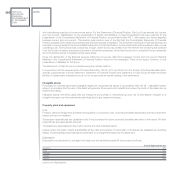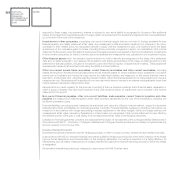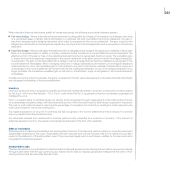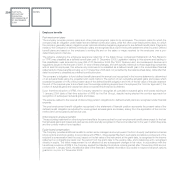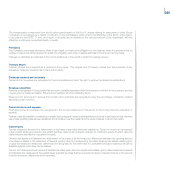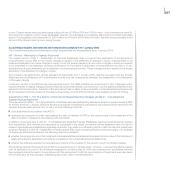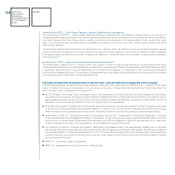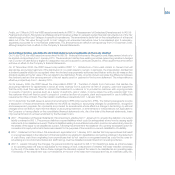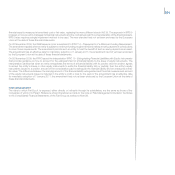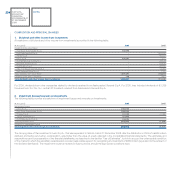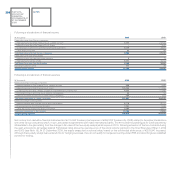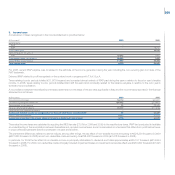Chrysler 2009 Annual Report Download - page 291
Download and view the complete annual report
Please find page 291 of the 2009 Chrysler annual report below. You can navigate through the pages in the report by either clicking on the pages listed below, or by using the keyword search tool below to find specific information within the annual report.
FIAT S.P.A.
STATUTORY
FINANCIAL
STATEMENTS AT
31 DECEMBER
2009
NOTES
290
The amendment is effective from 1 January 2010. At the date of adoption the classification of all land elements of unexpired
leases must be reassessed, with any lease newly classified as a finance lease to be recognised retrospectively.
IAS 38 - Intangible Assets: IFRS 3 (as revised in 2008) states that if an intangible asset acquired in a business combination
is separable or arises from contractual or other legal rights, sufficient information exists to measure its fair value reliably;
amendments are made to IAS 38 to reflect that revision of IFRS 3. Moreover these amendments clarify the valuation techniques
commonly used to measure intangible assets at fair value when assets are not traded in an active market; in particular, such
techniques include discounting the estimated future net cash flows from an asset, and estimating the costs the entity avoids by
owning an intangible asset and not having to license it from another party in an arm’s length transaction or the costs to recreate
or replace it (as in the cost approach). The amendment is effective prospectively from 1 January 2010.
IAS 39 - Financial Instruments: Recognition and Measurement: this amendment restricts the non-applicability of IAS 39
under paragraph 2(g) of the standard to forward contracts between an acquirer and a selling shareholder to buy or sell an
acquiree in a business combination at a future acquisition date when the completion of the business combination is not
dependant on further actions of either party and only the passage of a normal period of time is required. Option contracts,
whether or not currently exercisable, which allow one party to control the occurrence or non-occurrence of future events
and on exercise will result in control of an entity are therefore included in the scope of IAS 39. The amendment also clarifies
that embedded prepayment options whose exercise price compensates the lender for the loss of interest income resulting
from the prepayment of the loan shall be considered closely related to the host debt contract and therefore not accounted
for separately. Finally, the amendment clarifies that the gains or losses on a hedged instrument must be reclassified from
equity to profit or loss during the period that the hedged forecast cash flows affect profit or loss. The amendment is effective
prospectively from 1 January 2010.
IFRIC 9 - Reassessment of Embedded Derivatives: this amendment excludes from the scope of IFRIC 9 embedded derivatives
in contracts acquired in a business combination, a combination of entities or businesses under common control or the
formation of a joint venture. The amendment is applicable prospectively from 1 January 2010.
In June 2009, the IASB issued an amendment to IFRS 2 - Share based payment: Group Cash-settled Share-based Payment
transactions. The amendment clarifies the scope of IFRS 2 and the interactions of IFRS 2 and other standards. In particular, it
clarifies that an entity that receives goods or services in a share-based payment arrangement must account for those goods or
services no matter which entity in the group settles the transaction, and no matter whether the transaction is settled in shares or
cash; moreover, it clarifies that a ‘group’ has the same meaning as in IAS 27 - Consolidated and Separate Financial Statements,
that is, it includes only a parent and its subsidiaries. In addition, the amendment clarifies that an entity must measure the goods
or services it received as either an equity-settled or a cash-settled share-based payment transaction assessed from its own
perspective, which may not always be the same as the amount recognised by the consolidated group. The amendments also
incorporate guidance previously included in IFRIC 8 - Scope of IFRS 2 and IFRIC 11 - IFRS 2 - Group and Treasury Share
Transaction. As a result, the IASB has withdrawn IFRIC 8 and IFRIC 11.The amendment is effective from 1 January 2010; the
European Union had not yet endorsed the amendment at the date of these financial statements.
On 8 October 2009, the IASB issued an amendment to IAS 32, Classification of Rights Issues in order to address the accounting
for rights issues (rights, options or warrants) that are denominated in a currency other than the functional currency of the issuer.
Previously such rights issues were accounted for as derivative liabilities. However, the amendment requires that, provided
certain conditions are met, such rights issues are classified as equity regardless of the currency in which the exercise price is
denominated. No effect is expected on the company’s financial statements from the adoption of this amendment.
On 4 November 2009, the IASB issued a revised version of IAS 24 - Related Party Disclosures that simplifies the disclosure
requirements for government-related entities and clarifies the definition of a related party. The revised standard is effective for
annual periods beginning on or after 1 January 2011. The revised standard had not yet been endorsed by the European Union
at the date of these financial statements.
On 12 November 2009, the IASB issued the first sections of IFRS 9 - Financial Instruments on the classification and measurement
of financial assets, having an effective date for mandatory adoption of 1 January 2013. The new standard represents the
completion of the first part of a project to replace IAS 39. The new standard uses a single approach to determine whether a


